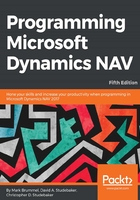
上QQ阅读APP看书,第一时间看更新
NAV object types
Let's start with basic definitions of the NAV 2017 object types:
- Table: Tables serve both to define the data structure and to contain the data records.
- Page: Pages are the way data is formatted and displayed appropriately for each of the client types and user roles.
- Report: Reports provide for the display of data to the user in hardcopy format, either onscreen (preview mode) or through a printing device. Report objects can also update data in processes with or without data display.
- Codeunit: Codeunits are containers for code utilized by other objects. Codeunits are always structured in code segments called functions.
- Query: Queries support extracting data from one or more tables, making calculations, and outputting in the form of a new data structure. Queries can output data directly to charts, to Excel, to XML, and to OData. They can be used as an indirect source for pages and reports.
- XMLport: XMLports allow the importing and exporting of data to/from external files. The external file structure can be in XML or other file formats.
- MenuSuite: MenuSuites contain menu entries that refer to other types of objects. MenuSuites are different from other objects. Menus cannot contain any code or logic. MenuSuite entries display in the Departments page in the navigation pane in the Windows client only. In the web and tablet clients, these are used to support search functions.